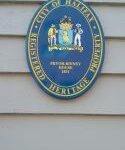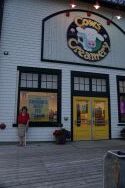August 5, 2018
 Nearly a week ago, we left Bloomington on my quest to add one more experience to my understanding of the French and Indian War. Having seen where it started (Fort Necessity, thanks to George Washington), Montreal and Quebec (1759 and 1760), the big battles that determined North America’s fate (France traded Canada for molasses islands), Fort De Chartres, the last French fort to be turned over to the British (and places like Manila, India, and Havana, where British and French clashed), not to mention San Souci, from where Frederick The Great directed his armies, Louisbourg remained—the bastion that guarded the entrance to the Saint Lawrence.
Nearly a week ago, we left Bloomington on my quest to add one more experience to my understanding of the French and Indian War. Having seen where it started (Fort Necessity, thanks to George Washington), Montreal and Quebec (1759 and 1760), the big battles that determined North America’s fate (France traded Canada for molasses islands), Fort De Chartres, the last French fort to be turned over to the British (and places like Manila, India, and Havana, where British and French clashed), not to mention San Souci, from where Frederick The Great directed his armies, Louisbourg remained—the bastion that guarded the entrance to the Saint Lawrence.
We’re not there yet—tomorrow is our invasion day—but so far, it’s been a 4  F vacation since we arrived in Halifax. The first F is for forts, and my thirst for forts (and more forts) has not yet been satisfied. Halifax itself was settled as a fort in the 1740s, preparation for the ongoing wars between Britain and France that lasted the better part of a century. It has the second largest ice-free harbor (Sydney is larger), and
F vacation since we arrived in Halifax. The first F is for forts, and my thirst for forts (and more forts) has not yet been satisfied. Halifax itself was settled as a fort in the 1740s, preparation for the ongoing wars between Britain and France that lasted the better part of a century. It has the second largest ice-free harbor (Sydney is larger), and  has been the home of the North Atlantic fleet. The Citadelle, built later, has reenactors. An extra: we learned Charles Williams was living in Halifax. Charles, a former Scout, might have been the most talented Scout in Troop 19 history. He did it “in full pack” as the saying went, and we were delighted to have dinner with him.
has been the home of the North Atlantic fleet. The Citadelle, built later, has reenactors. An extra: we learned Charles Williams was living in Halifax. Charles, a former Scout, might have been the most talented Scout in Troop 19 history. He did it “in full pack” as the saying went, and we were delighted to have dinner with him.

 It’s not the only fort here, for the area was a battleground not only between the British and the French, but between New Englanders and the French, and the British and the French Canadians (Acadians). Indeed, the first settlement (before Quebec) was in 1605 at Port Royal in the Bay of Fundy. An expedition from Virginia destroyed it in 1611 (the effort to rebuild it in the 1930s included a plan to ask the descendants of the destroyers to rebuild it).
It’s not the only fort here, for the area was a battleground not only between the British and the French, but between New Englanders and the French, and the British and the French Canadians (Acadians). Indeed, the first settlement (before Quebec) was in 1605 at Port Royal in the Bay of Fundy. An expedition from Virginia destroyed it in 1611 (the effort to rebuild it in the 1930s included a plan to ask the descendants of the destroyers to rebuild it).
When later generations of New Englanders grew exasperated by French-incited attacks, the Bay of Fundy was closer than Quebec, and expeditions came into the Bay to retaliate. And so we saw forts at Port Royal, and a neat one near Sackville, that changed names from Beausejour to Fort Cumberland when it went from French to British hands. (It successfully repelled a siege during the American Revolution, otherwise it might be named Fort Washington). Tensions with the United States lasted really until the 1840s, when Irish Americans sought to provoke a war between the United States and Great Britain in order to free Ireland. Indeed, there are a few islands that are still contested between the United States and Canada—ill-defined as far back as the treaty of 1783.
The Loyalists who went to St. John’s, New Brunswick, brought with them a plaque honoring King George III, which wound up in a church in their new home. 
The second F is for the French, whose history in the Maritime Provinces doesn’t stop in 1763, though there were several attempts to deport the settlers. Though parts of the area had been British since 1713, French Canadians were able to coexist with the British until the Seven Years’ War. At that time, the British demanded an oath of allegiance which included a willingness to fight against the French, if need be; earlier French Canadians had to swear the oath and did so with the proviso that they would not be forced to fight the French. Consequently, the British packed them up and shipped them off to France or elsewhere. Thus was born Cajun country in Louisiana.
 Many returned—after all, families had lived in the province for hundreds of years—but they were not given citizenship until the 19th century. Today, Acadians are part of Canada’s diverse population, but pockets (many in northern Nova Scotia and on Prince Edward Island) proudly fly a flag that resembles the French Flag, but has a yellow star on it. The original French settlement at Annapolis Royal was the capital city after the British conquered it until the British built Halifax.
Many returned—after all, families had lived in the province for hundreds of years—but they were not given citizenship until the 19th century. Today, Acadians are part of Canada’s diverse population, but pockets (many in northern Nova Scotia and on Prince Edward Island) proudly fly a flag that resembles the French Flag, but has a yellow star on it. The original French settlement at Annapolis Royal was the capital city after the British conquered it until the British built Halifax.

The third F is fishing villages—cute ones that dot the coast and indicate the importance of fishing; even in 1763 France held out for the right to dry cod on what is still French territory—St. Pierre and Miquelon. Towns like Peggy’s Cove and Lunenburg attract hordes of tourists for their scenery, houses, and ambience. Indeed, we saw little agriculture until we went to Prince  Edward Island, a province with about 150,000, resembling for all the world Wisconsin with cattle and corn (and oysters and lobsters and mussels—let’s not get too carried away). The staff at the bed and breakfast (one of two we’ve stayed at owned by Chinese—my Chinese got us upgraded in St. John) was studying “islands” at the University of Prince Edward Island, and how to develop sustainable agriculture on islands.
Edward Island, a province with about 150,000, resembling for all the world Wisconsin with cattle and corn (and oysters and lobsters and mussels—let’s not get too carried away). The staff at the bed and breakfast (one of two we’ve stayed at owned by Chinese—my Chinese got us upgraded in St. John) was studying “islands” at the University of Prince Edward Island, and how to develop sustainable agriculture on islands.

 The final F is for the Bay of Fundy, and its picturesque rocks (similar formations exist in the Pacific Northwest and Pictured Rocks, but Hopewell Rocks are on steroids) sculpted by the ocean. At low tide, you can walk around them; at high tide,
The final F is for the Bay of Fundy, and its picturesque rocks (similar formations exist in the Pacific Northwest and Pictured Rocks, but Hopewell Rocks are on steroids) sculpted by the ocean. At low tide, you can walk around them; at high tide, 
 the 40-foot swing in height covers the bases. Indeed, the tide in the Bay is the highest in the world, and it is used not only to attract tourists, (we paid $16 to walk over a “reversing falls” where the tide overcomes the St. John River and pushes it upstream), but to generate power.
the 40-foot swing in height covers the bases. Indeed, the tide in the Bay is the highest in the world, and it is used not only to attract tourists, (we paid $16 to walk over a “reversing falls” where the tide overcomes the St. John River and pushes it upstream), but to generate power.
Tomorrow the fifth F—Finally Louisbourg.